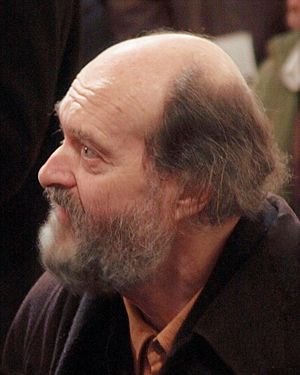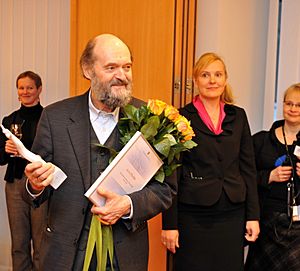Arvo Pärt facts for kids
Quick facts for kids
Arvo Pärt
|
|
|---|---|

Pärt at Christ Church Cathedral, Dublin, in 2008
|
|
| Born | 11 September 1935 Paide, Järva County, Estonia
|
| Alma mater | Estonian Academy of Music and Theatre |
| Occupation | Composer |
|
Works
|
List of compositions |
| Spouse(s) | Nora Pärt |
| Awards |
|
Arvo Pärt (born September 11, 1935) is a famous Estonian composer of modern classical music. He is known for creating a unique musical style called tintinnabuli, which he invented in the 1970s. This style is inspired by the simple, beautiful sounds of ancient Gregorian chant and ringing bells.
Pärt's music is often described as minimalist because it uses simple patterns and notes to create a powerful emotional effect. Some of his most famous pieces are Fratres (1977), Spiegel im Spiegel (1978), and Für Alina (1976). For many years, he was the most performed living composer in the world. In 2018, the Arvo Pärt Centre opened in Estonia to celebrate his work.
Contents
Early Life and Schooling
Arvo Pärt was born in Paide, Estonia. He grew up in the town of Rakvere with his mother and stepfather. The family piano was old and some of the keys in the middle were broken. As a child, Pärt loved to experiment with the high and low notes that still worked.
His formal music education started at age seven. By the time he was a teenager, he was already writing his own music. In 1954, he began studying at a music school in the city of Tallinn. He had to take a break to serve in the army, where he played the oboe and drums in the army band.
After the army, he returned to his studies at the Tallinn Conservatory (now the Estonian Academy of Music and Theatre). He studied composition with a teacher named Heino Eller. Pärt was so talented that people said, "he just seemed to shake his sleeves and the notes would fall out." He graduated in 1963.
A Composer's Career
Early Work
While he was a student, Pärt wrote music for over 50 movies and plays. This work allowed him to try out different musical ideas. From 1957 to 1967, he also worked as a sound producer for Estonia's public radio station.
At that time, Estonia was part of the Soviet Union, and the government had strict rules about what kind of art was allowed. In 1962, a government official criticized one of Pärt's early pieces, Nekrolog, for using a modern style called serialism. They felt it was too influenced by Western music.
However, Pärt's talent was hard to ignore. Just nine months later, he won first prize in a major competition with over 1,200 entries.
A Time of Change
In 1968, Pärt wrote a piece called Credo. It was a very religious work, which was not approved of by the Soviet government. Because of this, his music was banned from being performed in public.
This was a difficult time for Pärt. He felt he had lost his creative direction. For the next eight years, he stopped composing almost completely. Instead, he spent his time studying very old music, like medieval and Renaissance chants. He was searching for a new way to write music. During this period, in 1972, he also converted to the Orthodox Christian faith.
A New Beginning
In 1976, Pärt returned to composing with a completely new style he called tintinnabuli. This new music was calm, spiritual, and beautiful. It quickly made him famous around the world.
In 2014, a major newspaper called Pärt "possibly the world's greatest living composer." When asked if his music was Estonian, he said, "I don't know what is Estonian... My Kalevipoeg is Jesus Christ," referring to the fact that his inspiration comes from his faith, not from national stories.
Pärt's Musical Style
Pärt's music is often divided into two main periods.
First Period: Modern Experiments
His early music was influenced by famous 20th-century composers like Shostakovich and Prokofiev. He also experimented with complex, modern techniques like the twelve-tone technique.
However, these styles got him into trouble with Soviet officials and didn't feel right to him personally. After his piece Credo was banned, he entered his period of silence to find a new path.
Second Period: The Sound of Bells
After years of studying ancient church music, Pärt developed his unique tintinnabuli style. The word tintinnabuli comes from the Latin word for "bells." His goal was to create music that sounded as pure and clear as the ringing of bells.
This new music is known for:
- Simple Harmonies: It often uses single notes or simple chords.
- Steady Rhythm: The tempo, or speed, of the music usually stays the same.
- Spiritual Feeling: Many of his later works are based on sacred religious texts. He often uses Latin or Church Slavonic (an ancient language used in the Orthodox Church) for the lyrics.
Famous pieces from this period include Cantus in Memoriam Benjamin Britten and Tabula Rasa. His choral (choir) music, like Magnificat, is also very popular.
Awards and Recognition
Pärt has received many awards from all over the world for his music.
- 1996 – American Academy of Arts and Letters Department of Music
- 1996 – Honorary Doctor of Music, University of Sydney
- 1998 – Honorary Doctor of Arts, University of Tartu
- 2003 – Honorary Doctor of Music, Durham University
- 2006 – Order of the National Coat of Arms 1st Class
- 2007 – Brückepreis
- 2008 – Léonie Sonning Music Prize, Denmark
- 2008 – Austrian Cross of Honour for Science and Art, First Class
- 2009 – Foreign Member, Serbian Academy of Sciences and Arts
- 2010 – Honorary Doctor of Music, University of St Andrews
- 2011 – Chevalier (Knight) of Légion d'honneur, France
- 2011 – Membership of the Pontifical Council for Culture
- 2013 – Archon of the Ecumenical Patriarchate
- 2014 – Recipient of the Praemium Imperiale award, Japan
- 2014 – Honorary Doctor of Sacred Music, Saint Vladimir's Orthodox Theological Seminary
- 2016 – Honorary Doctor of Music, University of Oxford
- 2017 – Ratzinger Prize, Germany
- 2018 – Gold Medal for Merit to Culture – Gloria Artis, Poland
- 2018 – Honorary Doctor of Music, Fryderyk Chopin University of Music
- 2019 – Cross of Recognition, 2nd Class, Latvia
- 2020 – Frontiers of Knowledge Award, BBVA Foundation, Spain
- 2021 – Order of Merit of the Federal Republic of Germany
- 2022 – Officer of the Order of the Oak Crown, Luxembourg
- 2023 – Polar Music Prize, Sweden
- 2024 – Gold Medal of the Royal Philharmonic Society
Personal Life
In 1972, Pärt married his wife, Nora. Because of the problems with the Soviet government, Pärt and his family were allowed to leave Estonia in 1980. They lived first in Vienna, Austria, and later moved to Berlin, Germany.
Around the year 2000, he returned to Estonia. Today, he lives in the town of Laulasmaa, near the capital city of Tallinn.
In 2010, Pärt and his family started the Arvo Pärt Centre in Laulasmaa. It is a place where people can study his music and learn about his life. The center has a concert hall, a library, and his personal collection of work.
See also
 In Spanish: Arvo Pärt para niños
In Spanish: Arvo Pärt para niños
- List of Estonian composers


